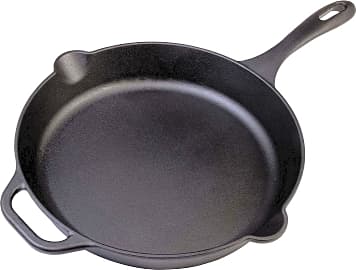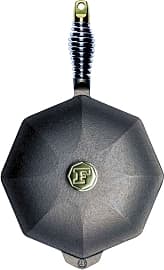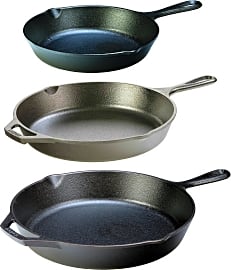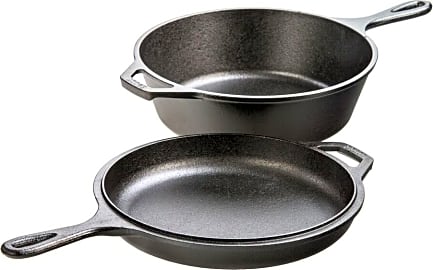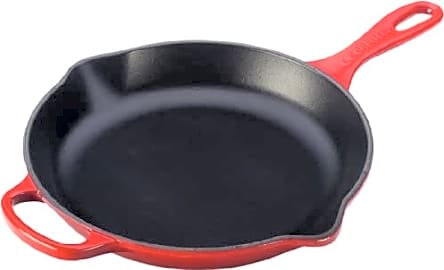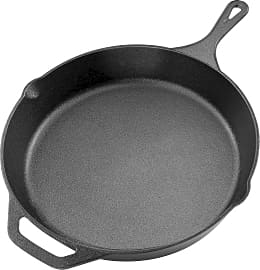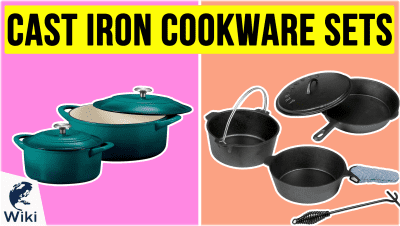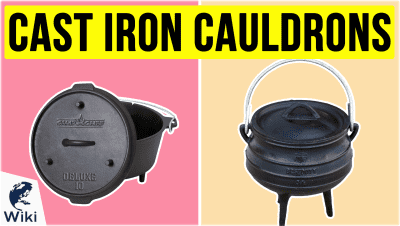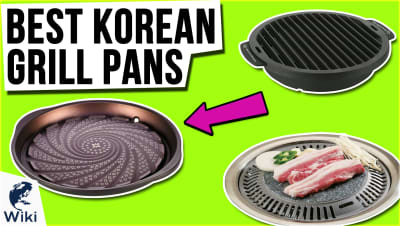The 10 Best Cast Iron Skillets

This wiki has been updated 39 times since it was first published in March of 2015. If you want a piece of cookware that's durable and versatile, you can't go wrong with one of these cast-iron skillets. They're good for everything from searing steaks and frying chicken to making sauces and baking cornbread, and you can use them in the oven, on the grill, or even over a campfire. Just don't use metal utensils on them, as that can strip away the seasoning. When users buy our independently chosen editorial choices, we may earn commissions to help fund the Wiki.
Editor's Notes
July 09, 2020:
In today’s update, we kept the Lodge Chef in the top spot, since it’s hard to beat when it comes to quality and price. There are many sizes to choose from, all of which feature comfortable teardrop-shaped handles. Also highly rated are the Lodge Bundle and the Lodge Combo. Both of these come with multiple pieces of cookware, providing a lot of bang for your buck. Lodge cast iron cookware is known for its ability to heat evenly and hold up to high temperatures, and for lasting over multiple decades, if not generations.
Today, we moved the Greater Goods 10-Inch up several spots on the list. This sturdy choice started out on Kickstarter and features machine-etched construction and a polish that provides a smooth surface. It’s been compared to old-fashioned Wagner and Griswold models in terms of quality and performance, and features two pour spouts and a comfortable handle, and is pre-seasoned with layers of cold-pressed, organic flaxseed oil. The Victoria SKL-212 retains a top spot on the list, as well, featuring sloping sides that are good for whisking sauces and spouts that are easy to pour from. We also added in the Utopia Kitchens Multipurpose, which replaces the similar, but now-discontinued Calphalon 12-Inch. This highly affordable choice comes pre-seasoned, and its large base makes it well suited for slow-cooking foods without burning them. Note that its surface is a bit rougher than some of the other options available. For a model that’s as decorative as it is functional, look to the Le Creuset Signature, which offers an exterior that is available in your choice of the company’s signature red, shades of blue, and more. The black enamel interior resists staining, dulling, and wear and tear. For more durable cookware designs, check our lists of best cast iron cookware sets and best cast iron dutch ovens.
May 20, 2019:
If you're looking for high quality at an affordable price, it's hard to do better than the Lodge Chef. It's seasoned using an electrostatic sprayer, which allows the oil to penetrate deep into the pores, and is available in nine sizes ranging from 3.5 to 15 inches in diameter. The Victoria Pre-Seasoned is another budget-friendly option that has contoured pour spouts to prevent drips, and it's made from recycled cast iron in a zero waste facility. The Lodge Combo Cooker gives you both a skillet and a Dutch oven for a highly affordable price, so you can sauté, braise, simmer, and deep fry, and the shallow pan can also be used as a lid.
For those who want a smooth surface like the ones found on antique pans made by Wagner and Griswold, the Greater Goods 10-Inch is an affordable option that's etched and polished on the bottom and sides. The Finex Modern Heirloom is much pricier, but it's handmade in the United States using high-quality materials, has a heat-resistant coiled handle, and comes with a lid. Both are seasoned with organic flaxseed oil for a durable nonstick finish.
Special Honors
Smithey No. 12 Cast Iron Skillet This durable, highly versatile choice can be used for anything from pan-frying chicken to searing steaks on the range to roasting vegetables in the oven to baking breads and biscuits. It’s also great for use on a grill or over a campfire. It sports a polished interior finish, and food won’t stick when the pan has been properly seasoned. It’s made in the United States and sports an ergonomic handle with multiple hanging holes, as well as spouts on both sides for easy pouring. smithey.com
Field Cast Iron Skillet No. 10 This handy cooking tool features a relatively light weight and a smooth, naturally nonstick surface. It’s well suited when you’re feeding a family, since it’s able to hold three New York strip steaks, or six fried eggs, or more than 11 cups of liquid at a time. It’s also available in four additional sizes, so there’s one for you whether you live alone or regularly feed a big crowd. It’s well balanced and can stand up to frequent use either at home or over the campfire. fieldcompany.com
Takes The Heat And Keeps On Going
Drying the skillet in a warm oven is also recommended to prevent rusting as well as to bake in the oil or shortening used for the seasoning.
Whether you consider yourself the family cook, a professional chef, or even a restaurateur, the kitchen is your castle of creation. The best chefs often have the most durable and modern kitchenware and appliances that are reliable, easy to use, and bring your food to life. No kitchen is complete without dependable ovens, cooking utensils, and various tools for searing, baking, frying, and preparing elaborate meals and dishes. Inexpensive, stick-resistant, and rugged durability are three integral qualities for getting the most out of your cookware. That said, a cast iron skillet is an example of all these qualities.
Unlike a sauté pan with its tall and vertical sides, the cast iron skillet is a flat-bottomed, multipurpose pan with a long handle and shallow sides that flare outward at an angle. One of its biggest advantages is its weight. Cast iron is not a good conductor of heat, which means that it takes longer to warm up and cool down than other types of pans. Its weight allows it to maintain very high temperatures for extended periods of time, making the skillet an excellent tool for searing and frying foods at very high temperatures.
Just the same, the skillet can be used to simmer your foods (i.e. lamb chops or steak) at a consistently low temperature. There is less of a restriction on the maximum temperature that can be reached with a cast iron skillet. It easily withstands temperatures up to five hundred degrees Fahrenheit. Even if you plan to use it over an outdoor campfire, it can take the heat.
Seasoning is an important factor to the quality and maintenance of a cast iron skillet. By seasoning in this context, we don't mean using salt and spices, but rather, some type of animal fat or cooking oil to form a nonstick coating. When oil seeps into the surface of a cast iron skillet, it eliminates any microscopic roughness on the metal that would otherwise cause food to cling to it. This process creates a stick-resistant surface.
Often times, skillets come pre-seasoned from the factory, but it's still a good idea to know how the seasoning process works. Cast iron should not be cleaned with detergents or abrasive steel wool, as this can strip the skillet's seasoning. By contrast, hot water and a non-abrasive sponge will usually do the job. Drying the skillet in a warm oven is also recommended to prevent rusting as well as to bake in the oil or shortening used for the seasoning.
Cast iron skillets are incredibly durable and resilient. Therefore, they can take a lot of abuse. When cared for properly, they will last for many years before needing to be replaced. They can also double as compact grilling sources when you don't have access to a barbecue or gas grill. They also offer the versatility to create meals for practically any time of day, including eggs, french toast, or browned chicken.
A Brief History Of Cast Iron Skillets
Cast iron has been an incredibly dependable cooking source for over two thousand years. Its history dates as far back as the Han Dynasty in China. Such vessels were valued for their strength and ability to retain heat. Prior to the nineteenth century in Europe, most meals were prepared over a hearth or stove, which meant that cooking pots and pans had to be designed with either long handles or legs for suspension and standing over an open flame.
Cast iron has been an incredibly dependable cooking source for over two thousand years.
The concept of the dutch oven, for example, represented this early form of cast iron cooking (introduced during the Industrial Revolution), as these vessels typically featured long handles for hanging. With the growing popularity of cooking stoves in more homes during this era, legless, flat-bottomed cast iron cookware also became more common.
By the first half of the twentieth century, most modern homes had at least one cast iron cooking pan. Toward the latter part of the century, enamel-coated cast iron became one of the most highly-regarded forms of cookware, for which companies like Le Creuset have become famous.
Although the popularity of cast iron declined during the 1960s and 1970s in favor of teflon-coated aluminum, it still remains a dependable form of cookware because of its strength and ability to last, making the skillet an integral part of most any home or professional kitchen.
Cook To Your Skillet's Content
Because of a skillet's versatility to sear, fry, and brown a variety of comestibles for most any meal of the day, one must be sure to keep it well-seasoned (or to at least ensure proper pre-seasoning from the factory). Secondly, it should be safe for use in a conventional oven or on a stovetop. Some skillets are also compatible with induction cooktops.
Very sharp utensils could scratch off some of the coating with regular use, so this is important to take into account.
For the restaurateur or professional chef, the skillet is a necessary investment when considering large dinner rushes and the need to use the cookware over and over without wearing out. The heavier a skillet is, the better it can retain and evenly distribute heat for ensuring delicious meals.
Consider the type of handle for your intended skillet. It should be easy to hang and large enough to hold comfortably without overheating.
Many skillets come in a variety of different colors with enamel coating for extra protection. However, if choosing enamel coating, one must also consider the types of utensils (i.e. spoons, forks, or knives) they plan to use.
Very sharp utensils could scratch off some of the coating with regular use, so this is important to take into account. On the upside, enamel surface coating can also minimize one's need to constantly re-season the skillet.


